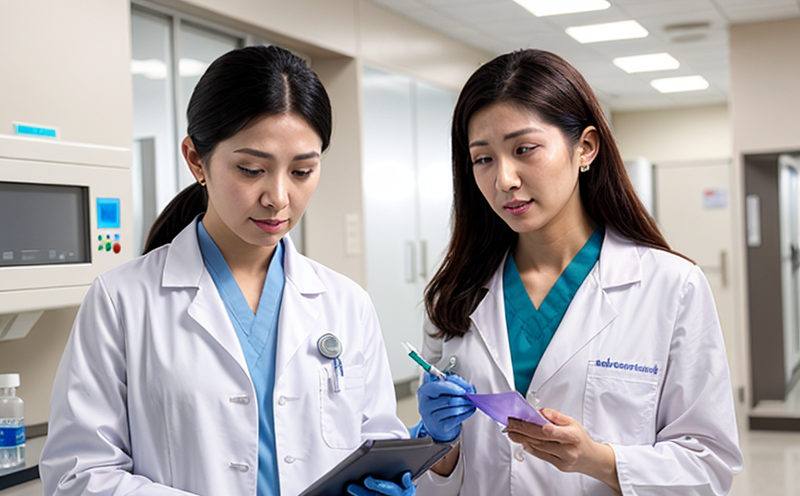ICH Q5B Analysis of DNA Sequences Testing
The ICH (International Conference on Harmonisation) guideline Q5B provides comprehensive recommendations and standards for the analysis of DNA sequences in biopharmaceuticals. This testing is critical to ensure that biosimilars are structurally similar to their reference products, with no clinically meaningful differences. The goal is not only to verify the identity of the product but also to assess its purity and potency.
Accurate DNA sequence analysis is foundational in biopharmaceutical development as it impacts regulatory compliance, patient safety, and drug efficacy. This service involves a detailed examination of the nucleotide composition across various regions of interest within the DNA molecule. The process begins with sample preparation, where genomic material must be isolated from the biological source using appropriate techniques to ensure minimal degradation or contamination.
Once the sample is prepared, it undergoes amplification and sequencing processes. Polymerase Chain Reaction (PCR) is often used for target enrichment, followed by next-generation sequencing technologies such as Illumina or Thermo Fisher Scientific’s Ion Torrent systems. These sophisticated instruments generate vast amounts of sequence data which are then analyzed using bioinformatics software.
The analysis focuses on identifying polymorphisms, mutations, and structural variations that could affect the drug's performance. Any discrepancies detected must be thoroughly investigated to determine their impact on the product. Compliance with regulatory standards like ICH Q5B ensures that these tests meet rigorous quality requirements, thereby enhancing public health.
Understanding the implications of DNA sequence data is crucial for pharmaceutical companies as it guides decisions regarding formulation optimization, process improvements, and ultimately, clinical trial design. By adhering to these guidelines, manufacturers can demonstrate robust evidence supporting the safety and effectiveness of their biopharmaceuticals.
Why It Matters
The ICH Q5B standards are essential for ensuring that biosimilars are safe and effective alternatives to reference products. Compliance with these guidelines is not only a legal requirement but also a testament to the quality and reliability of the manufacturing process. Here’s how this testing impacts various stakeholders:
Manufacturers: By adhering strictly to ICH Q5B, companies can maintain consistent product quality throughout their lifecycle. This reduces the risk of adverse events in clinical trials and post-marketing use.
Regulatory Authorities: These guidelines provide a uniform framework for evaluating biosimilars across different countries, promoting international harmonization and mutual recognition agreements (MRAs).
Patients: Ensuring the accuracy of DNA sequence analysis helps prevent the introduction of unsafe or ineffective products into the market, thus safeguarding public health.
The importance of this testing extends beyond mere compliance; it plays a pivotal role in advancing scientific knowledge and improving therapeutic outcomes. As research continues to uncover more about genetic factors influencing drug response, accurate DNA sequence analysis becomes increasingly vital for personalized medicine approaches.
Customer Impact and Satisfaction
The impact of ICH Q5B compliance on customer satisfaction is profound. For pharmaceutical companies, meeting these standards translates into enhanced product quality, reduced development timelines, and increased confidence among regulatory bodies. Patients benefit from safer treatments that are more likely to be effective for them.
Quality managers and R&D engineers at pharmaceutical firms often rely heavily on ICH Q5B analysis results when making critical decisions about drug formulation and manufacturing processes. This service ensures they have reliable data supporting their choices, leading to higher levels of customer trust and satisfaction.
Compliance officers also find value in this testing as it provides robust evidence needed for audits and inspections by regulatory agencies. The ability to demonstrate adherence to international standards instills confidence in both internal stakeholders and external partners alike.
International Acceptance and Recognition
The ICH Q5B guidelines have gained widespread acceptance and recognition worldwide due to their comprehensive approach to DNA sequence analysis. Many countries, including those in Europe (EN), North America (ASTM), Asia-Pacific region (IEC), and beyond, have incorporated these standards into their regulatory frameworks.
Pharmaceutical companies operating globally find it advantageous to comply with ICH Q5B as it facilitates smoother interactions with various regulatory bodies. This international acceptance reduces barriers to market access for biosimilars, encouraging innovation while maintaining high safety and efficacy standards.
The recognition of ICH Q5B by numerous stakeholders underscores its significance in the field of biopharmaceuticals. As more countries adopt these guidelines, they contribute to a more harmonized regulatory landscape that benefits all parties involved—from developers to end-users.





